15-Minute Yoga Flow for Stress Relief
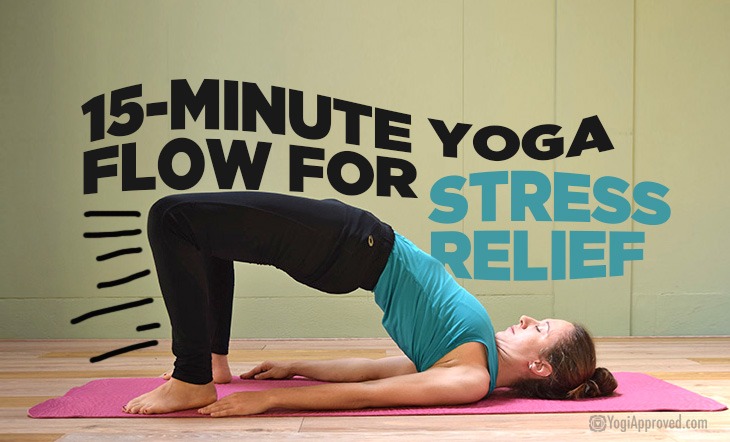
Our modern lifestyle is very busy. Family, career, social life . . . The pressure is high. From a young age, we are encouraged to perform intellectually, physically, professionally and socially. Unfortunately, a very common result of this constant pressure is . . . STRESS. What if you could gift yourself 15 minutes of yoga?
Controlled and limited stress is not necessarily a bad thing. Stress can actually help you perform under pressure, excel during a job interview, reach deadlines, etc.
However, constant and overwhelming stress can have a negative effect on your physical and mental wellbeing. It can even lead to a series of health problems such as anxiety, insomnia, high blood pressure, muscle soreness, reduced immune system and much more. According to research, stress can even lead to serious health problems such as heart disease, depression and obesity.
“It is health that is real wealth and not pieces of gold and silver.” – Mahatma Gandhi
Therefore, it is important – no matter how busy your schedule – to take time for yourself. By reducing your stress levels and calming down your mind and body, you will feel better immediately, and will experience lasting energy, positivity, and health overall.
Enjoy This Free Yoga for Stress Relief Class with Ashton August
How Yoga Fits Into the Mix, Even 15 Minutes of Yoga
Unfortunately, when people get overwhelmed with stress, they don’t always handle it the right way. Commonly accepted ways to unwind are lying on the sofa staring at the TV, using drugs or alcohol to forget stress and tensions, eating junk food, or taking medication.
Yet there are much more efficient ways to unwind and learn to control your stress before it starts to control you. One of those ways is a regular yoga practice.
Several studies suggest that yoga can reduce the impact of chronic and exaggerated stress and that it can also be helpful to relieve anxiety and depression.
When the body is in a state of stress, the sympathetic nervous system automatically activates. In this “fight-or-flight” response, the body temperature rises, the heart beats faster and the muscles automatically become tense, ready to fight or flight.
One of the main benefits of yoga is that it activates the parasympathetic nervous system, which is the body’s “rest-and-digest” system. When in this state, the body spends its energy on healing, recuperating and digesting. As a result, your immune system and overall body and mind well-being improve.
Aside from activating the parasympathetic nervous system, yoga also gives you access to an inner strength and calmness which empowers you to deal with life’s inevitable stressors, fears, and frustrations.
But What If I Have No Time?!
Even though many people agree with these facts, lack of time is a problem that still remains. If you have to carve another hour out of your already busy schedule, yoga could easily become an extra thing to add to your to-do-list.
But good news! It’s not required that you practice yoga for one hour every day. Even if you only practice for 15 minutes a day, you will still benefit from yoga’s effects. Just 15 minutes of yoga can make a tremendous difference in your energy levels and in how you deal with daily tensions and pressure.
You owe it to yourself to find at least 15 minutes a day to do something good for your mind and body.
The following yoga sequence is based on the sequence of Swami Sivananda. Note that some poses from his sequence are not included, and the duration of other poses has been reduced in order to fit a maximum amount of beneficial poses and exercises into 15 minutes.
This is an easy sequence that can be practiced both by beginner and advanced practitioners. The sequence covers breathing, warm-up, inversion, forward bend, backbend, standing pose and last but not least, a short final relaxation.
Grab Your Yoga Mat, and Let’s Get Started On Our 15-Minute Yoga Practice for Less Stress:
1. Nadi Sodhana – Alternate Nostril Breathing (2 minutes)
The best way to prepare your body, breath and mind for a yoga practice is with Alternate Nostril Breathing. This powerful breathing exercise balances the left and right side of the brain and calms the mind. It brings harmony between the logical (left) and creative, emotional (right) side of the brain and creates an overall sense of clarity.
How to practice this form of Pranayama:
- Sit in a comfortable position
- Bring your left hand in Chin Mudra (touching the tip of your thumb and index finger) and your right hand in Vishnu Mudra (extend all fingers straight, then bend the index finger and middle finger)
- Close your right nostril with your right thumb and breathe in through your left nostril for 4 counts
- Keep your right thumb on your right nostril and also close left nostril with right ring finger and little finger. Hold your breath for 8 counts
- Release only your thumb, and breathe out through your right nostril for 8 counts
- Breathe in through your right nostril for 4 counts
- Close both nostrils again and hold your breath for 8 counts
- Breathe out through your left nostril for 8 counts
This is one round. Continue this breathing exercise for 2 minutes. During the exercise, keep your focus on your breath, following each inhalation and exhalation. This form of Pranayama activates the parasympathetic nervous system, slowing down your heartbeat and breath.
The left and right hemispheres of the brain receive an equal amount of oxygen because you breathe in and out separately through each nostril for the same duration. As a result, the hemispheres come into balance and the mind calms down.
Looking for more yoga tutorials and yoga tips? Check out our full library of Yoga articles here
2. Surya Namaskar – Sun Salutation (3 minutes)
After calming down and balancing the mind, it is time to warm up the body and in particular, the spine. This is best done with a few rounds of Sun Salutations, or Surya Namaskar. Try to harmonize your breath and your body as you smoothly move from one position into the next.
These are the steps for Sun Salutation:
- Breathe in, breathe out and bring your palms together at heart center
- Breathe in, lift your arms up and back, gently press your pelvis forward
- Breathe out, bend forward and place your hands next to your feet
- Breathe in, and take a halfway lift, hands to shins or thighs
- Breathe out and fold, plant your palms and step your feet back into plank pose
- Breathe in at the top of your plank pose
- Breathe out, lower your knees, chest, then forehead down to the mat
- Breathe in, press your palms and legs into the mat and lift your chest into Cobra pose
- Breathe out, tuck your toes and lift your hips up and back into Down Dog (http://youaligned.com/yoga/downward-facing-dog-yoga-pose-tutorial-video/)
- Breathe in, step your right foot in between your hands
- Breathe out, step your left foot up to meet the right
- Breathe in, rise to standing and lift your arms overhead
- Breathe out, bring your palms together
This is half a round of Sun Salutation. Do the same flow starting with the left leg, and then you have completed one full round. After 3 minutes, take a short Savasana to allow your breath and heartrate to steady.
3. Sarvangasana – Shoulderstand (1 min.)
Shoulderstand is a very good pose for strengthening and balancing the thyroid gland which is responsible for the metabolism and growth of the entire body. This pose calms the brain and helps relieve stress and mild depression.
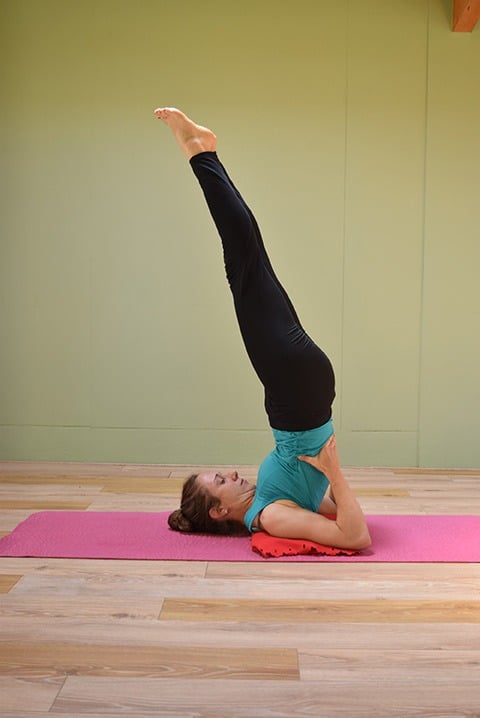
How to come into Sarvangasana:
- Lie on your back, feet together, arms by your side
- For extra cushioning and to release strain from the neck, place a folded blanket under your shoulders (neck should remain free)
- Lift your legs skyward, and place your hands on your hips. Begin to walk your hands up the back towards your shoulder blades
- Try to bring your chest to your chin but keep the back of your head relaxed on the floor
- Feet begin to extend beyond the head and remain relaxed
- To come out of this pose, place your hands on the floor for support, bend your knees, and slowly roll down one vertebrae at a time
When you are in the pose, keep your legs and feet relaxed, keep your gaze up and don’t move your neck. Bring your focus to your thyroid gland, or Throat Chakra, (http://youaligned.com/om/the-throat-chakra-how-it-impacts-your-ability-to-communicate/) and allow the benefits of the pose to take hold in the mind/body.
4. Ardha Setu Bandhasana – Half Bridge (30 seconds)
Half Bridge Pose opens the chest and stretches the neck and spine. It is a therapeutic pose for fatigue and insomnia. It rejuvenates tired legs and reduces stress and anxiety.
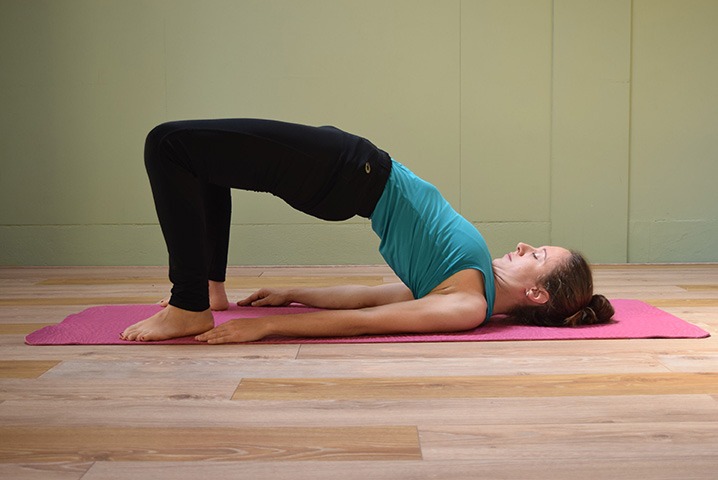
How to come into Half Bridge:
- Lie on your back, soles of the feet planted flat on the floor close to the buttocks. Arms are relaxed by your side, palms facing down
- On an inhalation, press your palms into the floor and lift your pelvis as high as possible
- Reach with your hands towards your heels and try to touch your chest to your chin
- With each inhalation, try to lift your pelvis a little higher
5. Gomukhasana – Cow Face (30 sec. each side)
A regular practice of Gomukhasana, or Cow Face Pose, is very beneficial for people sitting at a desk all day. This pose improves posture and relieves tension from the neck and shoulders. It opens the chest and also relieves emotional tension and irritation.
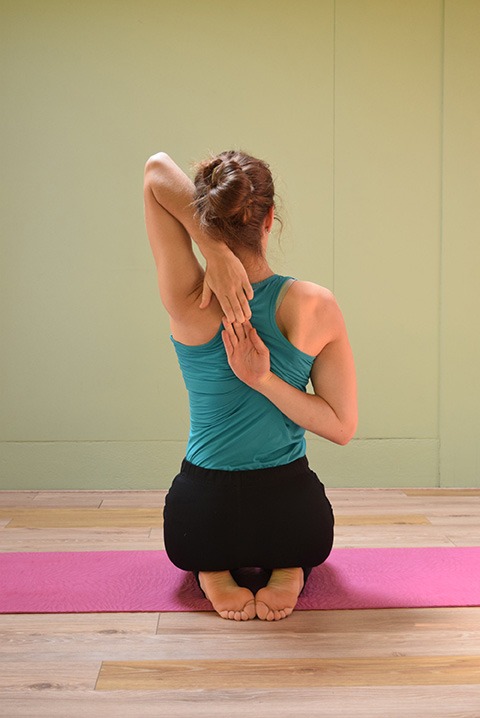
How to come into Cow Face:
- Begin sitting on the mat and bend your right knee so the kneecap faces the front of your mat
- Work to stack your left knee directly on top (or as close as you can comfortably get)
- Wrap your right hand behind your back and reach it towards your shoulder blades as high as possible
- Reach your left hand up towards the ceiling and then try to touch your fingers at the center of your back (if they don’t connect yet, use a strap or towel)
- Keep reaching upward with your left elbow, and looking straight ahead, keep a tall and elongated spine
- Hold this pose for 30 seconds and then repeat on the other side
6. Paschimottanasana – Seated Forward Bend (30 sec.)
Seated Forward Bend is an excellent pose that gives a powerful massage to your internal organs. It stimulates all the organs, and particularly the liver and the spleen. Paschimottanasana is very beneficial for people suffering from constipation because it improves digestion. It also reduces fatigue and helps combat headaches.
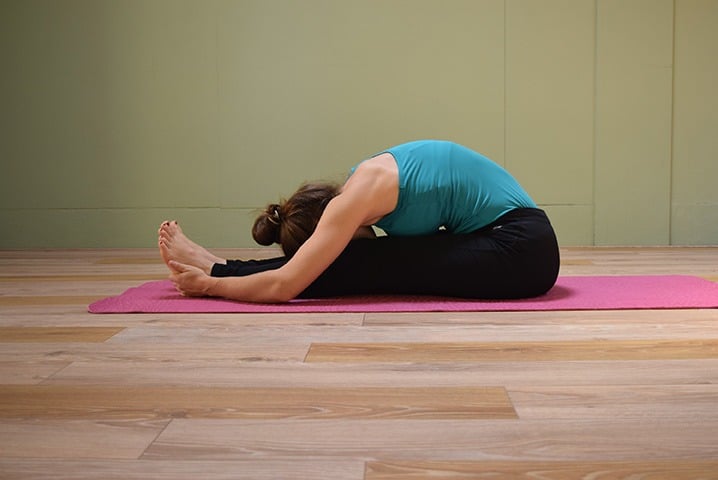
How to practice a Seated Forward Bend:
- Sit on the floor with your legs extended straight out in front of you
- Inhale and lift your arms overhead, making your spine long and tall
- Exhale and bend forward, bringing your nose toward your toes
- Keep your feet actively flexed back towards your face to help release the hamstrings
- Drop the head completely and relax your arms and shoulders
- Avoid using any muscular force to come deeper into the pose, but do try to use your breath to lengthen the spine and relax more into the stretch
7. Bhujangasana – Cobra Pose (30 sec.)
Cobra is another pose that stimulates the digestive system and simultaneously stretches the spine and strengthens the back muscles and shoulders. It expands the ribcage and increases the lung capacity. Therefore, Cobra can be a therapeutic pose for people with asthma or any other respiratory issues. Practice this pose regularly to improve your posture and reduce stress and fatigue.
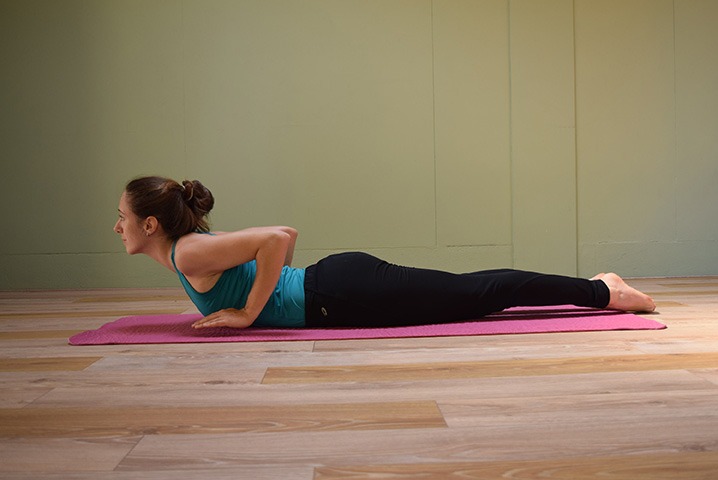
How to practice Cobra:
- Lie on your belly, forehead on the mat, palms planted next to your chest, feet together
- Breathe in, push your belly and hips into the floor and lift your chest off the floor
- Look straight ahead, just beyond the front edge of your mat, and lift your palms off the floor for extra spinal strengthening
8. Dhanurasana – Bow Pose (30 sec.)
Practicing Bow Pose gives your internal organs a massage, particularly the pancreas, liver and kidneys. It improves hunchback (rounded upper back) because it opens the shoulders and the neck. Dhanurasana also relieves menstrual discomforts and stimulates the reproductive organs.
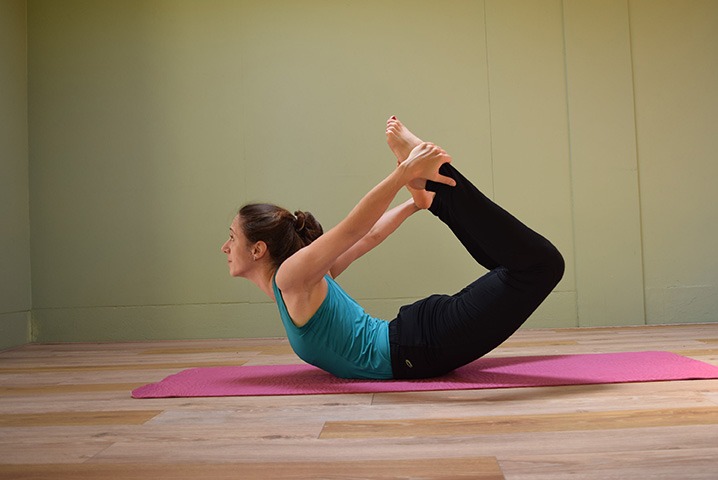
How to come into Bow Pose:
- Lie down on your belly, forehead on the floor, bend your knees and reach back for your ankles
- Breathe in and kick your feet into your hands so your knees and chest lift off the floor, keeping the knees hip-width apart
- Open and expand through your chest, and send your gaze skyward
- While you remain in the pose, focus on pressing down through your belly and lifting up through your chest
9. Tadasana – Mountain Pose (30 sec.)
Mountain Pose is a very powerful pose to improve mental and physical balance. It increases awareness and calms the mind as well as the breath. Practicing Tadasana relieves tension and aches throughout the body, and will leave you feeling refreshed and rejuvenated.
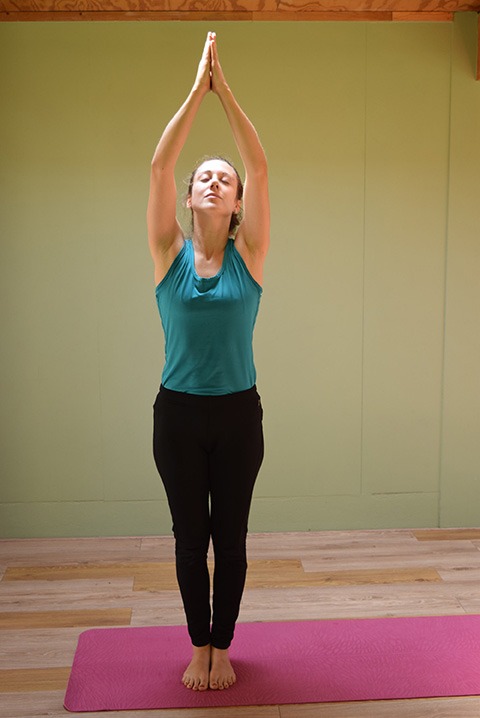
How to practice Tadasana:
- Standing straight, feet together, spine tall and reaching up through the crown of your head
- Bring your palms together at heart center and on an inhalation, lift your arms overhead
- Spiral your pinkies inward to engage your arms, option to lift your gaze skyward or look straight ahead (eyes open or closed)
20. Final relaxation (5 min.)
Taking Savasana – your final resting pose – is very important at the end of every yoga practice. Depending on how much time you have, you can spend 5 to 15 minutes in final relaxation. Savasana increases the benefits of your practice and gives rest to your mind and body so you emerge balanced and refreshed. Take this final pose in complete silence and stillness, allowing your body to soften and fully relax into the mat.
15-Minute Yoga Practice Can Reduce Stress and Increase Presence
We all feel it – busy and overwhelmed. Self-care is deeply valuable. Swap out the social scrolling for this 15-minute yoga practice and feel the difference in your life.
It is a very common saying that you can’t take care of others if you can’t take care of yourself.
No matter how busy your days are, it is important to never lose track of your most important duty, which is to take care of yourself. Try to keep that thought in mind whenever you think you are too busy to spend even just 15 minutes a day on your own growth and wellbeing.
To end with the wise words of Buddha, “You yourself, as much as anybody else in the entire universe, deserve your love and affection.”
Reduce Stress With This Guided Mediation With Youaligned Founder Ashton August
To feel grounded is to feel a sense of being supported, safe, and calm. This guided meditation on YA Classes is designed to help you feel grounded during and after, which helps relieve stress and soothe anxiety, and can also help you feel mentally clear and focused. Not yet a member? Try it out for free for 14 days.


This Month's Letter
From the Editor
Monthly motivation and food for
thought from our founder.

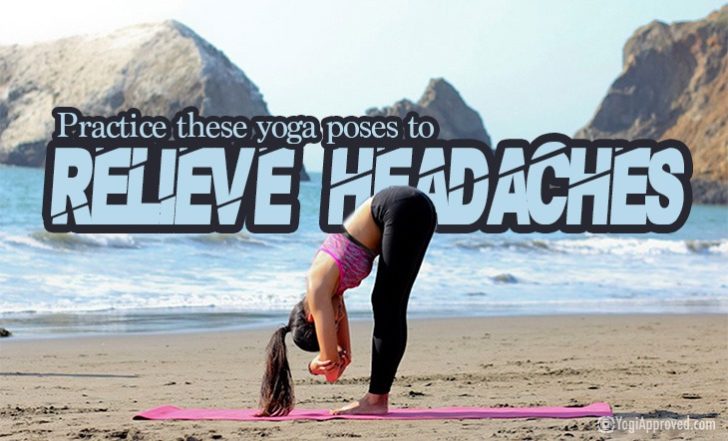
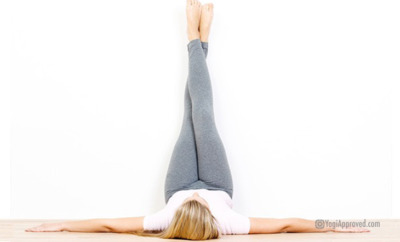
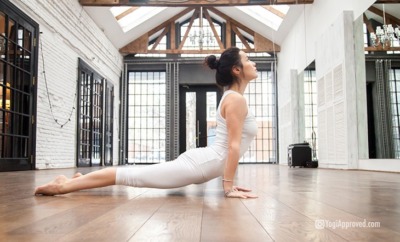
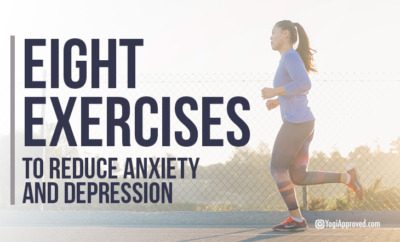

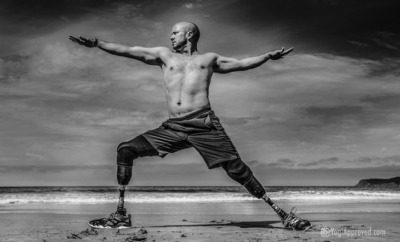






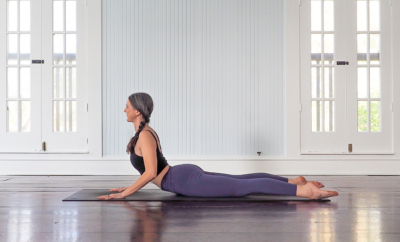
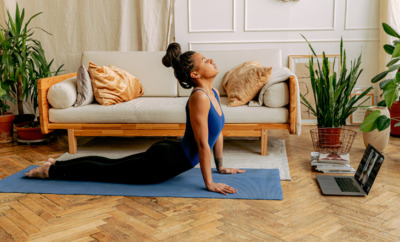
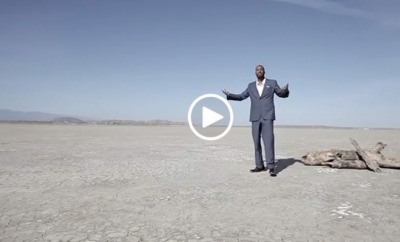








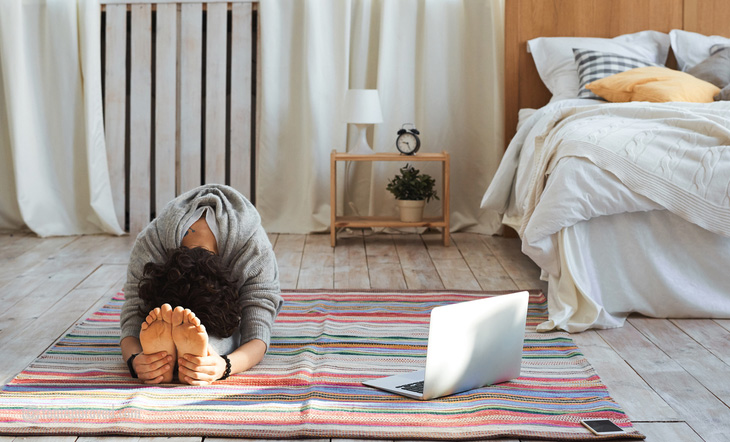
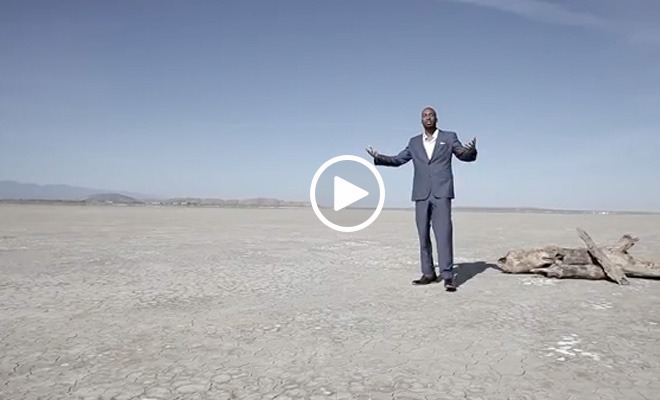




Comments